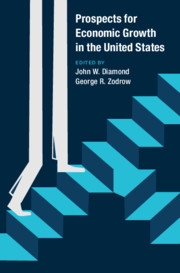Book contents
- Prospects for Economic Growth in the United States
- Prospects for Economic Growth in the United States
- Copyright page
- Dedication
- Contents
- Figures
- Tables
- Notes on Contributors
- Foreword
- Preface
- Acknowledgments
- Part I Overview
- Part II Labor and Economic Growth
- Part III Implications of Technology for Growth
- 5 “The $64,000 Question”: Living in the Age of Technological Possibility or Showing Possibility’s Age?
- 6 Artificial Intelligence Technologies and Aggregate Growth Prospects
- Part IV The Effects of Fiscal Policy on Growth
- Part V Special Topics on Economic Growth
- Part VI A Concluding Perspective
- Index
- References
5 - “The $64,000 Question”: Living in the Age of Technological Possibility or Showing Possibility’s Age?
from Part III - Implications of Technology for Growth
Published online by Cambridge University Press: 21 October 2021
- Prospects for Economic Growth in the United States
- Prospects for Economic Growth in the United States
- Copyright page
- Dedication
- Contents
- Figures
- Tables
- Notes on Contributors
- Foreword
- Preface
- Acknowledgments
- Part I Overview
- Part II Labor and Economic Growth
- Part III Implications of Technology for Growth
- 5 “The $64,000 Question”: Living in the Age of Technological Possibility or Showing Possibility’s Age?
- 6 Artificial Intelligence Technologies and Aggregate Growth Prospects
- Part IV The Effects of Fiscal Policy on Growth
- Part V Special Topics on Economic Growth
- Part VI A Concluding Perspective
- Index
- References
Summary
Will economic and productivity growth be slower going forward than in US experience over the past century or even over the postwar period, as techno-pessimists suggest? Or will technological changes usher in a new era of faster productivity growth and enhanced welfare? Are “headwinds” to growth from demographic, competitive, and social trends bound to blunt potential gains trumpeted by techno-optimists? This chapter describes the key arguments of the techno-optimists and the techno-pessimists. It argues that there is little a priori reason to doubt that technological advances will continue. The debate should focus on the link between those advances and broad measures of productivity growth. Consistent with early periods of technological diffusion, the time period between general technological advances and their impact on productivity may be long; the chapter extends these arguments to contemporary discussions of AI and machine learning. While it shares concerns about macroeconomic headwinds to growth, the chapter emphasizes microeconomic policies to support intangible capital accumulation and its diffusion to general productivity, and finds for the techno-optimists.
Keywords
- Type
- Chapter
- Information
- Prospects for Economic Growth in the United States , pp. 115 - 131Publisher: Cambridge University PressPrint publication year: 2021

